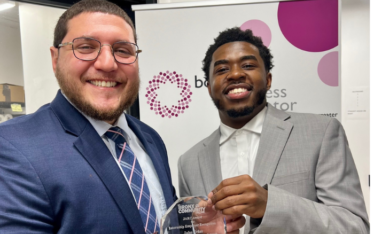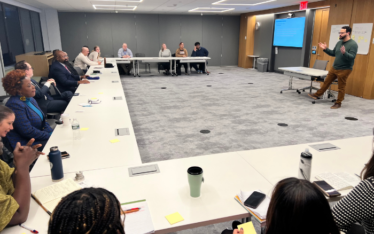Ryan Craig is the author of College Disrupted (2015) and A New U: Faster + Cheaper Alternatives to College (2018). He is a Managing Director at University Ventures, which is reimagining the future of higher education and creating new pathways from education to employment. This is an Op-ed piece. The views are the author’s and not those of JobsFirstNYC. .
In an era of natural disasters and pandemics, Build Back Better is a fair name for a policy platform. President Biden wants America to invest in new roads, bridges, digital systems, solar power, and electric cars. But even if the powers that be in DC decide to spend the money, many are asking whether we have the skilled workforce to do all this building.
Much of the agita concerns unfilled jobs. There are currently a record-high 10 million unfilled jobs. And that’s without investing trillions more to create millions of new jobs. While a lot of these unfilled jobs are frontline service jobs in retail and hospitality that need better pay and benefits to attract talent, millions are good jobs – full-time, $50K+ in salary, benefits, and multiple career paths for those lucky enough to land them. The problem is that employers aren’t seeing attractive candidates. The primary reason: the digital skills gap.
Why is there a digital skills gap? Primarily due to the digital transformation of business and the broader economy (including nonprofits and the public sector). It’s not just that there are more digital devices (or that you’re reading this on a screen). It’s that over the past decade, and particularly over the past year and a half, organizations have transformed their internal systems, as well as their processes for interacting with stakeholders – customers, suppliers, employees, shareholders – from informal and manual to formal software-based processes available remotely. Across all sectors, most middle- and high-skill jobs now involve managing some business function through software or software-as-a-service (SaaS) platforms. Before Covid, only 41 million American jobs still didn’t require significant digital skills; nearly 100 million did. That number is undoubtedly higher today.
But it’s inexact to generalize about a digital skills gap. The digital skills gap actually consists of thousands of micro-level or tactical digital skills gaps. The bigger digital skills gap extends to positions that aren’t considered “tech jobs.” These are roles that manage functions like supply chains, sales, marketing, customer service, finance, IT, and HR. Employers are seeking skills like Pardot (marketing), Marketo (digital marketing), Google Adwords (digital marketing), ZenDesk Plus (customer service), NetSuite (finance), Financial Force (finance), Workday (HR), and the customer relationship management (CRM) platform Salesforce – the most popular SaaS platform in American businesses. There are currently 300,000 open Salesforce positions with millions more to be created in the next five years.
Yes, new labor market entrants are digital natives and all have smartphones. But critical business SaaS platforms require specific know-how that’s a far cry from the relatively little you need to know to navigate Netflix, Spotify, and iOS interfaces. Because business can be hard and complex, no matter how user-friendly the design, business software is often really hard and complex.
The digital skills gap isn’t a secret. So why don’t millions of unemployed and underemployed workers go out and get these skills? One big reason is that the training isn’t available. A second and more intractable reason is that training isn’t enough, and most job seekers know it. Few employers are interested in hiring a candidate who’s just completed a training program. They’re looking for relevant work experience. This is the result of increased hiring friction in the economy.
Hiring friction is the reduced propensity of employers to hire candidates for positions that should be (or used to be) entry-level. It’s the result of a number of factors. First, the increased cost of making bad hires. Disastrous hires can cost employers six figures in lost productivity and termination expenses. Second, increased churn at the entry-level; about 50% of college graduates who start a new role churn out of those jobs within two years. So entry-level training becomes a fool’s errand for employers; if you invest in it, your competitors can poach your trained talent and free-ride off your investment.
The third and most important source of hiring friction is sclerotic hiring processes. Nearly every good job is posted online and generates hundreds of résumés. So employers utilize keyword-based filters called Applicant Tracking Systems to determine which résumés are actually seen by a human. If you don’t have sufficient keyword density, you’re not visible. Faced with the deluge of résumés over the past decade, HR and hiring managers have sought to tighten the screen and have done so by adding additional experience and skills to job descriptions. Which skills have they added? Unfortunately, there are only so many ways to say “critical thinking,” or “problem-solving.” So the skills that have been added to job descriptions are digital and software skills. Across virtually every industry, technical skills now outnumber all other skills in job descriptions, particularly for entry-level jobs. Without the digital skills employers are increasingly listing in entry-level job descriptions, too many college graduates are invisible for exactly the positions they want (and need in order to make student loan payments).
In 2019 the Trump administration announced that Ivanka’s ballyhooed “Pledge to America’s Workers” program had yielded commitments from 300 employers – including Microsoft, Apple, Lockheed Martin, and Toyota – to train more than 12M workers. Ivanka-led events at the White House featured testimonials from workers who benefited from training programs. Of course, as Bloomberg noted, “much of the training would have been done in the absence of Ivanka’s initiative.” And these days we’re not hearing much about this initiative from Ivanka or anyone else.
Most employers know what’s right and, pre-pandemic, at least paid lip service to it. In a poll around that time, 96% of “HR decision-makers” agreed that they “should be offering more apprenticeships and internships.” I’ve read countless op-eds and whitepapers urging employers to continue investing in upskilling, outskilling, tuition, training, or apprenticeships, and now even urging them to turn off applicant tracking systems. But the labor market we have and the one we wish for aren’t one and the same. If employers weren’t able to close the skills gap before, there’s little chance right now with the unprecedented disruption from Covid-19. For all employers, there are must-haves and nice-to-haves. Innovative hiring and upskilling initiatives definitely fall in the latter category.
If employers are unlikely to solve the problem themselves, what about colleges and universities? To this proposition, I say that no one has ever lost money betting against the pace of change in higher education. Here’s a list of things higher education institutions could be doing right now to help close America’s skills gap:
- Expand and standardize prior learning assessments for all incoming students.
- Mandate micro-credentials for all courses and programs.
- Turn degree programs upside down.
- Implement portable learner records.
- Require work-integrated learning for most courses.
- Change federal work-study to encourage useful work for outside employers rather than menial on-campus jobs.
- Facilitate off-ramps.
- Decentralize career services and integrate them into student lifecycle from freshman year.
- Connect students to online career exploration resources and short courses.
- Provide students with individualized career assessments.
- Staff career services with experienced professionals from desirable industries – not with career services lifers.
- Insist that employers shift to skills-based hiring (no degree requirements permitted in job descriptions) if they wish to recruit graduates.
- Track and report on employment outcomes by program/pathway for 12-24 months post-completion.
- Diversify program mix by introducing new faster + cheaper pathways to good first jobs.
- Develop partnerships with new hire/train/deploy pathways.
These fifteen steps provide an actionable pathway for higher education institutions to revolutionize and diversify their approach to training and closing the skills gap. As we push to make one of the greatest economic comebacks in history, it is important for education and training to match the needs of the employers while empowering the people who make up the workforce.
There’s no question that faster + cheaper pathways to good jobs are needed now more than ever. But given continued hiring friction, it’s imperative that new public and philanthropic investments extend beyond training and upskilling to actual placement into good jobs. Having spent over 20 years in education, I’m not against upskilling. But upskilling isn’t sufficient to solve the colossal problem we now face. What I am against is spending precious time and resources on mindless upskilling i.e., upskilling with no clear employment destination. What unemployed and underemployed Americans need now are jobs, not the opportunity to learn online.
The good news is that many employers just need a kick-start or incentive to take a chance on unproven talent. So it’s time we moved from a paradigm of funding only education and upskilling to funding job placement, with clear standards on what constitutes a good job worth paying for (e.g., full-time $50k+ with multiple career paths).
There are many potential models for this. But most require intermediaries to stand between employers and candidates and clear away the frictions that block potentially qualified candidates from good jobs.
- How about an American version of the UK’s “pay for performance” funding model for apprenticeships which funds employers and intermediaries for every successful placement of a qualified candidate into a good job?
- Or an American version of Australia’s incentive for Group Training Organizations to hire, train, and deploy new workers?
- Why not assemble a consortium of staffing companies and fund them to screen, match, hire, and staff candidates with existing employer-clients at highly discounted rates for a period of time? By absorbing all the risk from hard-pressed employers (including serving as employer of record for the duration of the trial period), the staffing industry’s ubiquitous and proven temp-to-perm model has the potential to put millions back to work quickly.
Building back better will require America to do some things we haven’t done in a very long time, but also some new things. In an era of natural disasters and pandemics, it’s not too much to ask that we rethink how we spend education and workforce dollars.





